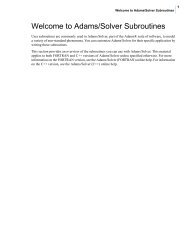You also want an ePaper? Increase the reach of your titles
YUMPU automatically turns print PDFs into web optimized ePapers that Google loves.
2.7 Setting Fixture Compensation<br />
Using <strong>Virtual</strong> <strong>Machine</strong> Models with CeRun and Gener<br />
Setting Fixture Compensation<br />
Motion data is processed in relation to the machine origin. On most<br />
modern machines, the machine origin (i.e., the position at which all<br />
axes read zero) can be adjusted by the NC operator. Many CNCs<br />
provide for the definition of multiple origins with fixture (or workpiece) compensation. VM<br />
provides a virtual controller that supports both fixture and tool compensation. The VM controller<br />
can be activated from the View toolbar by selecting the button shown circled in the toolbar<br />
above. Select the button a second time to either hide the controller window or to restore a controller<br />
window that has been minimized. This window can also be controlled by selecting Simulation»Controller<br />
from the menu bar.<br />
Once the VM Controller<br />
window is active, select the<br />
Fixture Compensation tab to<br />
define or modify workpiece<br />
offsets. VM supports the<br />
definition of a global “base”<br />
offset, as well as individual<br />
workpiece offsets to match<br />
those in use at the machine.<br />
Fixture compensation data is<br />
automatically saved in the<br />
verification setup (.vsw) file when the program is completed. This setup file will be reused on<br />
subsequent runs to quickly reestablish the workpiece compensation settings necessary for an<br />
accurate simulation.<br />
Base compensation adjusts the machine zero point. All coordinate data is transformed by the<br />
base amount, regardless of the current workpiece compensation settings. Base compensation<br />
should not normally be used except in cases where the machine has a settable zero and no other<br />
form of workpiece compensation. In this case, the base compensation can be used to adjust the<br />
machine zero point to match the zero point that will be set by the NC machine operator.<br />
Fixture compensation offsets are defined relative to the base zero point. Press the Add button<br />
and enter the fixture compensation ID to be added, using the same form of ID numbers you<br />
would use in the CUTCOM/ADJUST command with GENER (e.g., for many controls, the range<br />
1-6 represents G54-G59). You can select any axis of any ID and type a new value. You can also<br />
select one or more IDs and use the Set and Zero buttons to set or zero offsets for all selected IDs<br />
simultaneously. The Add button will be disabled if fixture compensation is not available for the<br />
selected machine. Base compensation is always available.<br />
By accurately setting fixture compensation values, you can obtain a more realistic and complete<br />
simulation of the machine.<br />
<strong>ICAM</strong> provides “Manufacturing Extractors” for many popular CAM systems, which can automatically<br />
define fixture (i.e., workpiece) compensation settings matching coordinate frames used<br />
in the NC program.<br />
<strong>ICAM</strong> Technologies Corporation – Proprietary 23















